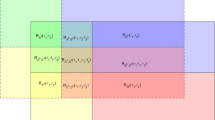Abstract
This paper presents a Zadoff-Chu matrix transform (ZCMT) precoding based multicarrier orthogonal-frequency-division-multiplexing (OFDM) system to minimize the high peak-to-average power ratio (PAPR). In the proposed system, ZCMT kernel is applied to the constellation symbols which not only reduces PAPR but also improves bit-error-rate (BER) performance. The ZCMT precoded OFDM signals allow the radio-frequency high-power-amplifier (HPA) to operate near its saturation level, thus maximize the power efficiency. Extensive computer simulations have been performed to analyze the PAPR, BER and power-spectral-density (PSD). Simulation results show that the proposed system has excellent PAPR gain and BER performance with no spectral distortion.
Similar content being viewed by others
References
Wu Y., William Z. Y. (1995) Orthogonal frequency division multiplexing: A multi-carrier modulation scheme. IEEE Transactions on Consumer Electronics 41: 392–399
Muquet B., Wang Z., Giannakis G. B., Courville M., Duhamel P. (2002) Cyclic prefixing or zero padding for wireless multicarrier transmissions. IEEE Transactions on Communications 50: 2136–2148
Nee R. V., Wild A. (1998) Reducing the peak-to-average power ratio of OFDM. 48th 3: 2072–2076
Nikookar H., Lidsheim K. S. (2002) Random phase updating algorithm for OFDM transmission with low PAPR. IEEE Transaction on Broadcasting 48(2): 123–128
Kou Y., Lu W., Antoniou A. (2007) A new peak-to-average power-ratio reduction algorithm for OFDM systems via constellation extension. IEEE Transactions on Wireless Communications 6(5): 1823–1832
Lim D. W., No J. S., Lim C. W., Chung H. (2005) A new SLM OFDM scheme with low complexity for PAPR reduction. IEEE Signal Processing Letters 12(2): 93–96
Jiang T., Yao W., Guo P., Song Y., Qu D. (2006) Two novel nonlinear companding schemes with iterative receiver to reduce PAPR in multicarrier modulation systems. IEEE Transactions on Broadcasting 52(2): 268–273
Mourelo, J. T. (1999). Peak to average power ratio reduction for multicarrier modulation. PhD thesis, University of Stanford, Stanford.
Yoo S., Yoon S., Kim S. Y., Song I. (2006) A novel PAPR reduction scheme for OFDM systems: Selective mapping of partial tones (SMOPT). IEEE Transactions on Consumer Electronics 52(1): 40–43
Han S. H., Lee J. H. (2004) PAPR reduction of OFDM signals using a reduced complexity PTS technique. IEEE Signal Processing Letters 11(11): 887–890
Wang L., Tellambura C. (2005) A simplified clipping and filtering technique for PAR reduction in OFDM systems. IEEE Signal Processing Letters 12(6): 453–456
Park M., Jun H., Cho J., Cho N., Hong D., Kang C. (2000) PAPR reduction in OFDM transmission using Hadamard transform. Proceedings of International Conference on Communications 1: 430–433
Min, Y. K., & Jeoti, V. (2007). A novel signal independent technique for PAPR reduction in OFDM systems. International Conference on Signal Processing, Communications and Networking, 2007 (ICSCN 07) (pp. 308–311).
Sun, E., Yi, K., Tian, B., & Wang, X. (2006). A method for PAPR reduction in MSE-OFDM systems. 20th International Conference on Advanced Information Networking and Applications, 2006 (AINA 2006).
Baig, I., & Jeoti, V. (2010). PAPR analysis of DHT-precoded OFDM system for M-QAM. 2010 International Conference on Intelligent and Advanced Systems (ICIAS) (pp. 1–4).
Baig, I. & Jeoti, V. (2011). A novel precoding based hybrid MC/SC radio access system for PAPR reduction in layered OFDMA of LTE-advanced IAENG. International Journal of Computer Science, 38(4), 314–319.
Baig I., Jeoti V. (2011) On PAPR reduction in SLM-OFDM systems: A ZCT precoding Based SLM Technique. Journal of Engineering Science and Technology (JESTEC) 6(3): 357–368
Tasi, Y., Zhang, G., & Wang, X. (2006). Orthogonal polyphase codes for constant envelope OFDM-CDMA system. In IEEE, WCNC, 2008 (pp. 1396–1401).
Zhengdao W., Georgios B. G. (2003) Complex-field coding for OFDM over fading wireless channels. IEEE Transactions on Information Theory 49(3): 707–720
Jeong Y. H., Oh K. N., Park J. H. (1999) Performance evaluation of trellis coded OFDM for digital audio broadcasting. Proceedings of the IEEE Region 10 Conference 1: 569–572
Ruiz A., Cioffi J. M., Kasturia S. (1992) Discrete multiple tone modulation with coset coding for the spectrally shaped channel. IEEE Transactions on Communications 40: 1012–1029
Sadjadpour, H. R. (1999). Application of turbo codes for discrete multi-tone modulation schemes. In Proceedings of the international conference on comunications (vol. 2, pp. 1022–1027). Vancouver, BC, Canada
Liu Z., Xin Y., Giannakis G. B. (2003) Linear constellation precoding for OFDM with maximum multipath diversity and coding gains. IEEE Transactions on Communications 51(3): 416–427
Rugini L., Banelli P., Giannakis G. B. (2004) MMSE-Based Local ML Detection of Linearly Precoded OFDM Signals. IEEE International Conference on Communications (ICC) 6: 3270–3275
Wang, Z., & Giannakis G. B. (2001). Linearly precoded or coded OFDM against wireless channel fades? In Proceedings of the Workshop On Signal Processing Advances In Wireless Communication (pp. 267–270). Taoyuan, Taiwan, ROC
Ortín J., García P., Gutiérrez F., Valdovinos A. (2009) Channel independent precoder for OFDM-based systems over fading channels. IEEE Transactions on Broadcasting, 55(4): 818–825
Popović, B. M. (1997). Spreading sequences for multi-carrier CDMA systems. In IEE colloquium CDMA techniques and applications for third generation mobile systems (pp. 8/1–8/6). London
Mow, W. H. & Li, S. -Y. R. (1992). Aperiodic autocorrelation properties of perfect polyphase sequences. In Proceedings of the 1992 international symposium on information theory and its applications (isita ’92) (pp. 1232–1234). Singapore
Pereira, J., & Silva, H. (2009). Generalized chu polyphase sequences. In Proceedings of the 16th international conference on telecommunications (pp. 47–52). Marrakech, Morocco.
Tsai Y., Zhang G., Wang X. (2008) Polyphase Codes for Uplink OFDM-CDMA Systems. IEEE Transactions on Communications 56(3): 435–444
Yue-liang, L., Yu-zhong, J., & Wei, Z. (2011). Interpolation algorithm of Zadoff-Chu sequence. 2011 international conference on mechatronic science, electric engineering and computer. Jilin, China.
Rappaport T. S. (2002) Wireless communications: Principles and practice. (2nd ed.). Prentice Hall, Englewood Cliffs, NJ
Guidelines for the evaluation of radio transmission technologies for IMT-2000. (1997). Recommendation ITU-R M.1225.
Author information
Authors and Affiliations
Corresponding author
Rights and permissions
About this article
Cite this article
Baig, I., Jeoti, V. A ZCMT Precoding Based Multicarrier OFDM System to Minimize the High PAPR. Wireless Pers Commun 68, 1135–1145 (2013). https://doi.org/10.1007/s11277-012-0501-1
Published:
Issue Date:
DOI: https://doi.org/10.1007/s11277-012-0501-1




